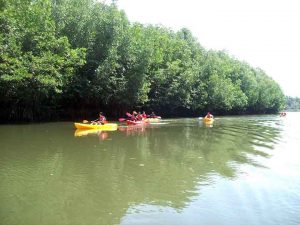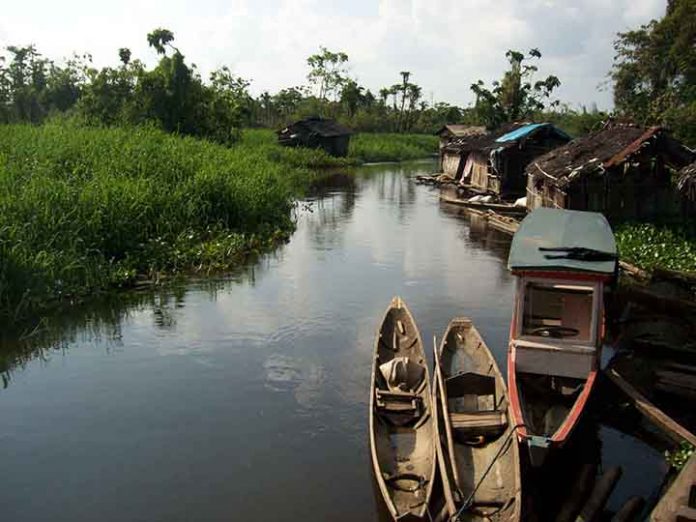“Wetlands, which include mangroves, are good natural buffers against stronger and more frequent typhoons, possible storm surges, and sea level rise.” – Dr. Theresa Mundita S. Lim, director of Biodiversity Management Bureau
***
The Philippines, with more than 7,000 islands, is one of the world’s most beautiful countries. To most foreigners, images of dreamy beaches and crystal waters surely dominates their perception of the country.
Unfortunately, it is also one of the world’s most disaster-prone countries as it is located in what scientists called as the “Ring of Fire.” The United Nations Office for Disaster Risk Reduction rates the Philippines as one of the 10 countries worst affected by weather-related emergencies.
The Philippines, experts claim, is very vulnerable to effects of climate change. “The signs are all around us,” said Senator Loren Legarda, who chairs the Senate Committees on Finance and Climate Change. “The numbers speak for themselves. It is no longer an issue of taking action, but rather of how much action we need to take.”
Scientists claim that if global temperature rises by 2°C, sea level rise is projected to be less than 70 centimeters; with warming of up to 4°C, sea level rise is projected to be more than 100 centimeters.
Various studies show that sea level rise around the country is three to five times faster than the global average rate. Quoting the World Meteorological Organization, Legarda warned: “Even if we are successful in limiting global warming to 1.5°C, sea level around the Philippines would still rise to about 70 centimeters.”

Indeed, it is very alarming. “The Philippines is one of the most vulnerable countries to climate change impacts,” declares Dr. Theresa Mundita S. Lim, the director of the Biodiversity Management Bureau (BMB), a line agency of the Department of Environment and Natural Resources. “We cannot emphasize enough how our wetlands can help protect communities, especially the poor who are most vulnerable and last resilient.”
Paul A. Keddy, author of Wetland Ecology: Principles and Conservation, defines wetland as “an ecosystem that arises when inundation by water produces soil dominated by anaerobic processes which, in turn, forces the biota, particularly rooted plants, to adapt to flooding.”
A patch of land that develops pools of water after a rain storm would not be considered a “wetland,” even though the land is wet. Specifically, wetlands are characterized as having a water table that stands at or near the land surface for a long period each year to support aquatic plants.
Under the Ramsar international wetland conservation treaty, wetlands are defined as follows:
Article 1.1: “… wetlands are areas of marsh, fen, peatland or water, whether natural or artificial, permanent or temporary, with water that is static or flowing, fresh, brackish or salt, including areas of marine water the depth of which at low tide does not exceed six meters.”
Article 2.2: “(Wetlands) may incorporate riparian and coastal zones adjacent to the wetlands, and islands or bodies of marine water deeper than six meters at low tide lying within the wetlands.”
In simpler terms, wetlands occur where water meets land. They include mangroves, peatlands and marshes, rivers and lakes, deltas, floodplains and flooded forests, rice-fields, and even coral reefs.
The Ramsar Convention is an intergovernmental treaty that provides the framework for national action and international cooperation for the conservation and wise of wetlands and their resources.
In the Philippines, there are six wetlands of international importance; these are Agusan Marsh Wildlife Sanctuary in Mindanao, Naujan Lake National Park in Oriental Mindoro, Olango Island Wildlife Sanctuary in Cebu, Puerto Princesa Subterranean River National Park in Palawan, the Tubbataha Reefs Natural Park in Sulu Sea, and the Las Piñas-Parañaque Critical Habitat and Ecotourism Area.
Peatlands, also known as mires, have been confirmed in Sab-a basin in Leyte and Agusan March in Mindanao. There are also some reports that peatlands also exist in Ligwasan Marsh in Mindanao, Dolongan area in Basey, Samar, Southern Leyte, Mount Pulag in Northern Luzon, Surigao del Norte, Northeastern Mindanao, and Naujan Lake Marshland.
Although their basic function is to conserve and provide water, “wetlands also play a significant role in climate change adaptation and disaster risk mitigation,” to quote the words of Legarda.
Take the case of mangroves. “Mangroves act as natural barriers in coastal areas, protecting communities from storm surges, waves, tidal currents, and typhoons,” said Dr. Alice Joan G. Ferrer, a professor of the Division of Social Sciences at the University of the Philippines in Miag-ao, Iloilo.
Some scientific studies have shown that “a barrier of mangroves over 100 meters wide can reduce wave height by between 13% and 66%.” In addition, “a per kilometer width of mangroves can weaken storm surge by 5-50 centimeters and surface wind waves by more than 75%.”
A couple of years ago, a powerful storm surges brought by typhoon Gener caused flooding in Manila’s bay area, forcing the Senate to shut down for a second time in a week and the US Embassy to cancel work at its chancery and suspend consular services.
Concrete seawalls that supposed to shield Roxas Boulevard were destroyed causing flood waters to submerge the area.
Concrete seawalls are not permanent solutions; they are expensive and will ultimately breakdown,” says Dr. Elmer S. Mercado, former undersecretary of the Department of Environment and Natural Resources.
Dr. Mercado cites the case of the tsunami that hit Japan some years back. “The 10-meter high seawalls did not save them,” he says. “What was worst was they got complacent that they continued building infrastructures along the coastal areas.”
If it happened in Japan, he says it will also happen in the Philippines. “We are worst here,” he reminds. “So, the best solution is to remove all settlements further back from main coastal areas and shorelines.”
Dr. Mercado also suggests that drainage systems be improved, natural catchment areas be built, and all obstructions in waterways be removed. “(If these recommendations are not followed) then people living in Metro Manila should be prepared to have Ondoy and Sendong scenarios every year and every time there is a typhoon.”
Wetlands, particularly mangroves, can serve as a natural safeguard against disasters and calamities. “Mangroves serve as coastal buffers and reduce coastal erosion,” points out Dr. Rafael D. Guerrero III, former head of the Philippine Council for Aquatic and Marine Research and Development. “The coastline of Manila Bay used to be full of mangroves. But with overexploitation and human settlements, they were denuded.”
As such, Dr. Guerrero suggests mangrove rehabilitation.
Aside from protecting communities from calamities and disasters, wetlands have other benefits, too. “Wetlands are likewise essential to food and water security and can provide alternative livelihood through ecotourism,” Legarda said. “Without wetlands, other ecosystems like marine and forest will all suffer. Species of birds, migratory and non-migratory, will also suffer as well as other flora and fauna.”
But wetlands, like other ecosystems, are on the verge of collapse. “Encroachment on, or loss of, wetlands can cause serious environmental damage to the ecosystem, so they should be restored and rehabilitated when possible,” the environment department suggested.
Wetlands should be conserved through “wise use,” which Ramsar Convention defines as “the maintenance of their ecological character, achieved through the implementation of ecosystem approaches, within the context of sustainable development.”
Legarda urged: “Each of us has opportunities to make a difference for our future. We must take hold of the opportunity to responsibly manage out wetlands. We must maintain focus and momentum in order to restore health to our wetlands and other critical ecosystems and thereby protect our citizens from the impacts of natural hazards and climate change.”







